#create a yard habitat
Text
Mama Mallard picked an unusual spot to make a nest. A planter outside a nosy downtown business. One year I made our yard so welcoming with leaf litter and not cutting back plants in the winter that a mallard couple tried to nest outside our garage door. A fox ate the eggs. When they came back to scope out the spot again the next year, I accidentally chased them away when I open the door and scared them. I didn’t know they were there.
#mallard duck#duck#urban wildlife#nature#nesting#birds#birds on tumblr#birdwatching#we don’t give animals enough habitat to thrive#quit building stupid houses#quit building shopping centers#leave wild space for animals#be kind to animals#create a yard habitat#plant native plants#remove invasive plants
1 note
·
View note
Text
Un-Actions, or Restriction of Activities
This is my first post in a series I’ll be making on how to increase biodiversity on a budget! I’m not an expert--just an enthusiast--but I hope something you find here helps!
There’s a good handful of ways you can help increase biodiversity in your yard that don’t require buying things--in fact, these may actually help you save money in the long run! They may seem small and simple, but every bit counts! Whether you can do these in totality, or just limit how often you do these actions, it’ll make a difference.
Not Mowing, or Mowing Less Often

Turf grass lawns are considered a monoculture, meaning they don’t provide much opportunity for insects to find habitat--so few other creatures find them enjoyable either. An expanse of turf grass is, in many ways, a barren wasteland in the eyes of wildlife--too exposed to cross, with few to no opportunities for food or shelter, leaving them exposed to blazing hot sun, freezing cold, or any predators that may be lurking nearby. A place to be avoided. The simple act of letting your grass grow unbothered gives a chance for wildflowers to grow, and for your grass to grow taller--providing more habitat for insects, which then provides more habitat to birds and other creatures that feed on said insects. Wildlife want nothing more than to skirt by unnoticed, so even leaving the grass tall along the edges of a fence or yard can help a little. Even restricting mowing to every other week, or at a higher blade setting, can be a huge help. If HOAs or city ordinances are fussy about lawn length in the front yard, you can likely still keep grass higher in the backyard. Or, you can create a ‘feature’ where grass is allowed to grow long in a specific area. If it looks purposeful, people are more likely to accept it. Not mowing under trees or close to shrubs not only leaves space for wildflowers to grow, but also means you don’t have to deal with mowing over bumpy roots and other difficulties. Cutting different areas at different times can be an option for letting grass grow long in some areas while still having available places for play and entertainment. I’ve seen some people plant flower bulbs when pulling up weeds, so in the future they'll bloom in early spring before mowing is usually necessary. This could be another fun way of adding biodiversity to a lawn without--or before you--begin mowing in spring.
Not worrying about mowing, or doing it less often, saves you in time, money, and energy. You won’t have to buy as much gasoline for your mower, and Saturday afternoons can be free to be enjoyed in other ways aside from being sticky and sweaty and covered in grass stains. In addition, you’ll likely be lowering your own carbon emissions!
If you do have to mow your lawn, I’ve got ways you can use your grass clippings to boost biodiversity later in the post series!
Not using pesticides, herbicides, fungicides, etc.
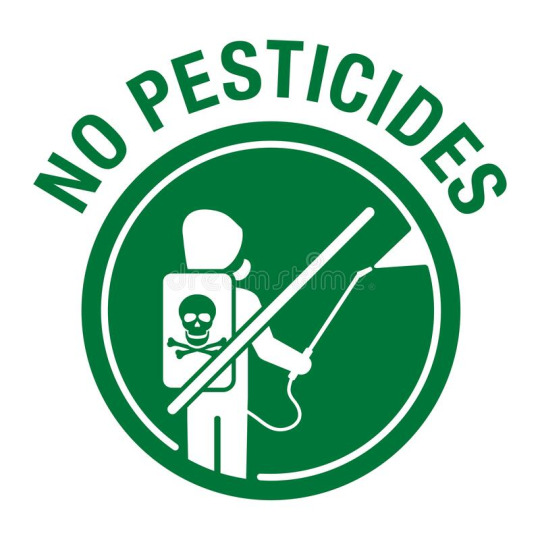
One of the next-biggest non-actions you can do asides from not mowing is using fewer fewer to no herbicides, fungicides, and pesticides in your yard. This’ll easily allow for more biodiversity. Allowing more insects and a wide array of plants to thrive will feed back into the entire food chain in your area. In addition, these types of chemicals have been tied to algae blooms, death of beneficial insects, harm to birds, fish, and even humans. Soil is supposed to be full of fungi, especially fungal mycelium that essentially acts as a network for plants to communicate, share nutrients, and support each other--fungicide kills that, and typically makes all other lawn problems even worse in a negative feedback loop. It may take awhile to see the benefits of avoiding these chemicals, but once you see it, it really is astounding.
However! I can’t lie and say that there haven’t been points where I needed to use pesticides at some points in my gardening journey. In these cases, try to use products that are organic--like diatomaceous earth, neem oil, etc--and use them accurately, correctly, and sparingly. Follow instructions on how to apply them safely and responsibly--for example, on non-windy days and during times when bees and other pollinators aren’t likely to be out and about. With some pests (read: oleander aphids, in my experience), a simple jetstream of water is enough to force them off the plant where they’ll be too weak to get back. Eventually, you should have a balanced enough ecosystem that no one insect pest causes a major issue with the work you’re doing to boost biodiversity.
If you can bear to, try handling pests manually. Squishing pest bugs in your hand is a pretty foolproof way to get rid of some problems, or spraying them with a mix of soap and water can do the trick on some insects. Alternatively, picking them off your plants and into a bucket of soapy water is also a valid option. You’ve heard of baptism by fire, now get ready for… baptism by soap?
But also! Try reconsidering what you consider a pest! Tomato hornworms are hated by gardeners, for devouring the foliage of beloved tomato, pepper, and potato plants. But killing the tomato and tobacco hornworm means getting rid of sphinx moths, also known as hummingbird or hawk moths! Hawk moths are vital to the survival of many native plants, and are sometimes even the only species that pollinates them. If you can bear to, consider sacrificing a few tomato plants, or growing a few extras, so we can continue having these beautiful moths for years to come. After all, they may not even do significant damage to the plants!

With that in mind, be friendly to your natural pest managers! Lacewings, ladybugs, praying mantises, wasps, birds, bats, and more will help manage pest populations in your environment! Encourage them by planting things they like, providing habitat, and leaving them be to do their work! Avoiding pesticides helps make your garden a livable environment for them, too!
Letting Weeds Grow
Many of the plants we know as 'weeds' are actually secondary succession species and native wildflowers. Milkweed was regarded as a noxious, annoying weed for a long time, and now people are actively trying to plant them after learning about the important role they play in our environments! Weeds are adapted to take over areas that have been cleared out of other plants after a disaster, so they're doing much of the initial work in making a habitat for other creatures. In fact, many of them will simply die back as the environment repairs itself.
An important thing to note is to please make sure that your ‘weeds’ are not invasive species. Work on learning how to identify native and invasive species in your area, and pull out what’s harmful to leave room for what’s good!
Don’t Rake (Or At Least Don’t Bag Your Leaves)

Many insects overwinter in piles of leaves that we often rake away and bag up in the fall and winter. By doing this, we are actively throwing away the biodiversity of our neighborhoods! If you can, leave the leaves where they fall!
If you do need to rake, put the leaves in places wildlife can still access it instead of bagging it up. Move your leaves into garden beds to serve as mulch, or along the edge of fences to rest while keeping egg cases and hiding bugs intact and free to release come spring.
Leave Snags Where They Are
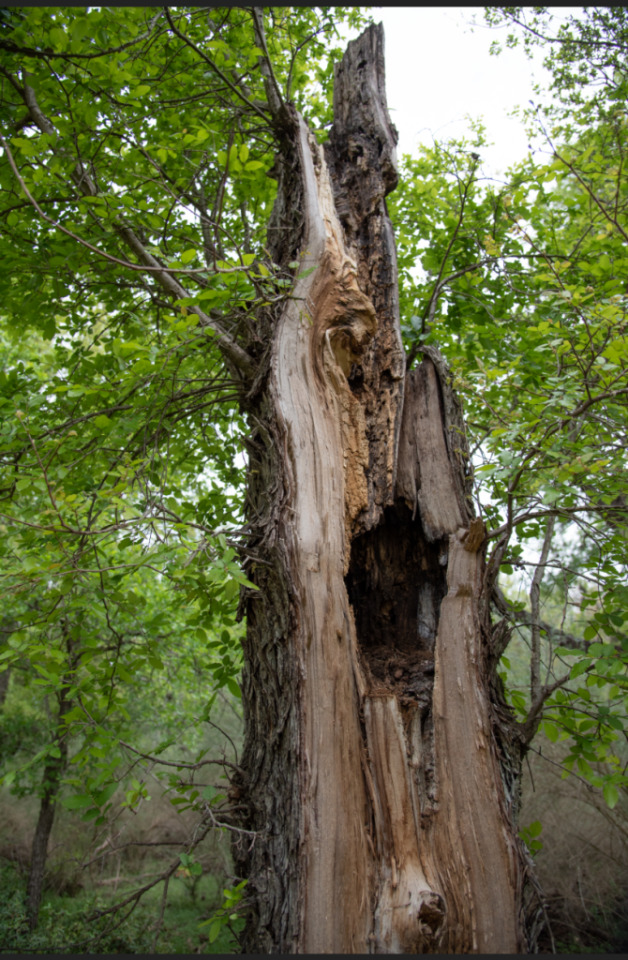
Snags are dead trees/dead branches on living trees. They provide an important wildlife habitat--many birds nest in them, or use them to seek cover from rain, and many insects will also live in snags (making them an additional food source for birds and other creatures). Tree cavities are used as nests by hundreds of bird species in the US, and many mammals use them as well, such as bats, squirrels, raccoons, and sometimes even bears. Some trees form cavities while they’re still alive, but in conifers they’re more likely to form after death. Crevices between the trunk of a dead tree and its peeling bark provide sun protection for bats and amphibians, and leafless branches make great perching areas for birds of prey to hunt from above. The decaying wood is home to insects and fungi, who then feed birds, mammals, amphibians, and reptiles. Do check on the snags regularly to ensure they don’t serve a threat to any nearby structures, but whenever possible, leave them be!
Keep Your Cat Inside
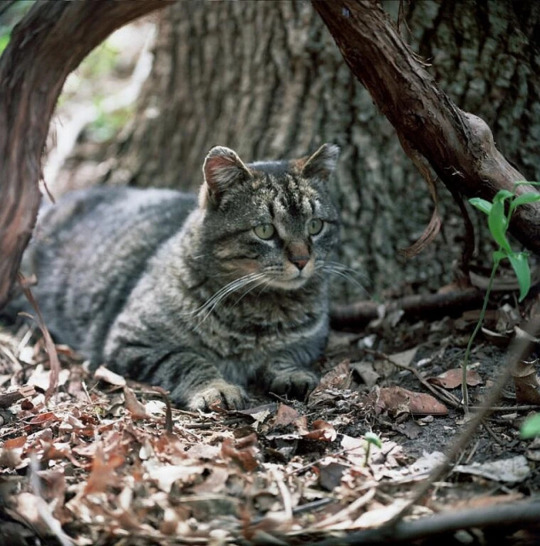
If you have an outdoor cat, consider making the adjustments to have it be an indoor cat. If you have an indoor cat, keep it as an indoor cat. Free ranging cats impact biodiversity through predation, fear effects, competition for resources, disease, and more. Keeping little Mittens inside does a lot more to help than it may seem from the outside.
That’s the end of this post! My next one’s gonna be on things you can add to your space that aren’t directly related to growing plants. For now, I hope this advice helps! Feel free to reply with any questions, success stories, or anything you think I may have forgotten to add in!
#biodiversity#solarpunk#gardening#outdoor gardening#lawn culture#anti lawn culture#environmental stewardship#(i think that counts)#ani rambles#out of queue#the biodiversity saga#I know I said this in the masterpost already but another reminder some people aren't in a position to do all or some or even any of this#i have so far been unsuccessful in convincing my parents to not mow or rake because we live in an HOA neighborhood#but do what you can/are able to! it'll help!
1K notes
·
View notes
Note
Hello!
My son recently brought home an Aron they captured while hiking in the local mountains and they really seem to have bonded well! (they are awfully cute) However, there's been a few... incidents that have made me concerned. Within the first month I found it chewing on a junk car we had parked in the back yard, and more worryingly, I've found it sniffing around at the foundation of our house.
I really don't want to have to force my son to release it back into the wild. I'm just really worried about them (literally) eating us out of house and home, especially considering that bridge that collapsed in Hoenn last year due to a pack of Arons.
Do you have any advice?
aron care can be tough because of their diet. we tend to keep a lot of metal around. but think of it this way: if you had a pet maschiff, would you put it in a room with a big bag of food unsupervised and expect it not to try and eat?
it's really important to make sure that, wherever your aron has its hang-out time without being watched, you've removed anything it can possibly eat. for an aron, that means either keeping it in a room with any metal it can reach removed or creating a smaller space that restricts its access to metal. a sturdy, reinforced plastic pen works well for aron. keeping it busy with toys and other forms of enrichment will also help reduce its desire to chew on random objects its finds. if it ever tries to eat something inappropriate, redirect its attention away from what it's trying to eat or recall it to its ball if necessary. aron should never be left around any sort of metal structure without someone keeping a close eye on them!
keep in mind too that the aron line has a strong sense of territory, and even if your son releases it, it may try to return- in which case your foundation would be in more danger. the best thing to do here is to make sure you're not giving it the chance to eat something it shouldn't through training and habitat management.
60 notes
·
View notes
Text
Things of dire importance about Outside in no particular order:
butterflies and many other beneficial insects spend the winter hibernating in fallen leaves. Please try to avoid shredding them, burning them, or God forbid, sending them to a landfill.
fallen leaves make amazing mulch and compost and getting rid of them is Incredible Folly
it is fine and normal for your plants' leaves to be munched on a little bit by bugs. if you plant a native flower, there's probably a butterfly or moth species whose caterpillars eat it for food. The babies have to eat okay. It's natural! It's good!
mushrooms=good. It is not a problem to have mushrooms in your yard. Most plants are in symbiotic relationships with fungi, that's how they get most of their phosphorous and nitrogen.
At least in the USA, no mushroom will poison you just by touch (barring allergies or some sensitivity like that I guess?). Unless you eat them, mushrooms will not hurt you.
If you happen to have a stream running through or alongside your property, do NOT mow right up to the edge. Plant moisture-loving trees, shrubs and plants to form a buffer zone. This helps stop harmful chemicals and pollutants from going into the water, prevents the stream bank from eroding, helps mitigate the risk of flash flooding, and creates absolutely essential habitat for some of the world's most at-risk creatures.
Trees can usually be planted as close as 6-10 feet apart from each other, but large trees should be kept 25+ feet from structures and septic tanks. Landscapers regularly plant trees WAY too close to structures.
Most butterflies and moths depend on specific plants for food for their caterpillars, hence the importance of native plants.
Many important bees hibernate over the winter in logs and stumps. Logs and stumps are good!
Acorns are ripe when they have fallen to the ground, they are brown and their little hats have popped off. If you rummage around in leaves under oak trees in October or so, you may find acorns that have already begun sprouting. You can put it in a pot and grow a new oak tree. (Sprout side down-that's the root!) It's so easy it feels illegal.
This is not true of some oak species, specifically white oaks (the ones with rounded lobes on their leaves- that's the simplified explanation). Their acorns have to experience a few months of cold before they sprout, so they will sprout in the spring, not fall. (Edit: I got it mixed up, it's red oaks that need cold to sprout and white oaks are the ones that can sprout immediately! Oops)
SO MUCH STUFF is going to seed right around the time that the leaves are falling. You can gather seeds from plenty of wildflowers along basically any weedy path or roadside.
thats all i've got for now
1K notes
·
View notes
Note
Does creating biodiversity in your yard lead to more bugs inside the house? I have a bad fear of cockroaches and I live in Texas. I want to do my part, but I also want to keep bugs out of my home.
Great question! From what I could tell from research, nobody's actually studied this much, so everything here is anecdotal. Some anecdotal evidence says it does, some says it doesn't. I personally have not noticed adding more biodiversity to outside spaces increasing the insects in my home, but I also haven't yet had the opportunity to undertake a major yard biodiversity project.
In my experience, bugs getting into your home depends on a lot more on other factors than yard biodiversity. So if you're concerned about cockroaches getting in, here are my thoughts:
Don't leave food out where possible - lots of bugs, including cockroaches, are attracted to easy sources of food. Cleaning up crumbs and rinsing leftover food off dishes and pans can discourage them.
Limit sources of water - standing water attracts all kinds of bugs, including cockroaches. Wipe up spills, make sure your drains are draining, don't let water sit in dishes too long, and make sure there's no leaky pipes providing sources of moisture.
Reduce clutter in dark, less-used spaces - if you have a lot of stuff in an attic, basement, or garage, consider decluttering or at least organizing it. Roaches love to hide in those spaces, and less hiding spaces makes it more likely they'll look elsewhere.
Create habitat far from your home - if cockroaches are common in your area, consider creating a habitat on your property but as far from your home as possible. Cockroaches don't care if they're in your house or somewhere else, they just want access to food, water, and shelter. If you give them somewhere to live besides your house (even a brush pile is good - anywhere shaded, full of small spaces, and preferably with some kind of water access), chances are good they'll go there instead of bothering with your house.
Consider a "barrier zone" around your home - creating biodiversity doesn't have to mean having a jungle right up next to your house. Consider creating a space directly around your house with very little shelter for bugs. It will discourage them from getting close to your home in the first place.
Seal cracks - cockroaches can get in through even tiny cracks and gaps. For extra help keeping them out, seal cracks around windows and doors and check for any gaps in walls or siding that they might be able to squeeze through.
Peppermint - roaches (and most bugs) hate the smell of peppermint. If it won't bother any pets or people in your home, consider spraying a peppermint scent around baseboards and places roaches like to hide. You could also consider planting peppermint close to your house or in your "barrier zone" to discurage them further (although all mint plants spread like crazy, so either create some sort of barrier or keep it in pots to keep it contained).
Hope this helps! Followers, feel free to chime in - especially anyone who knows more about insects and biodiversity in Texas specifically!
- Mod J
155 notes
·
View notes
Text
22 September 2023 - Friday Field Notes
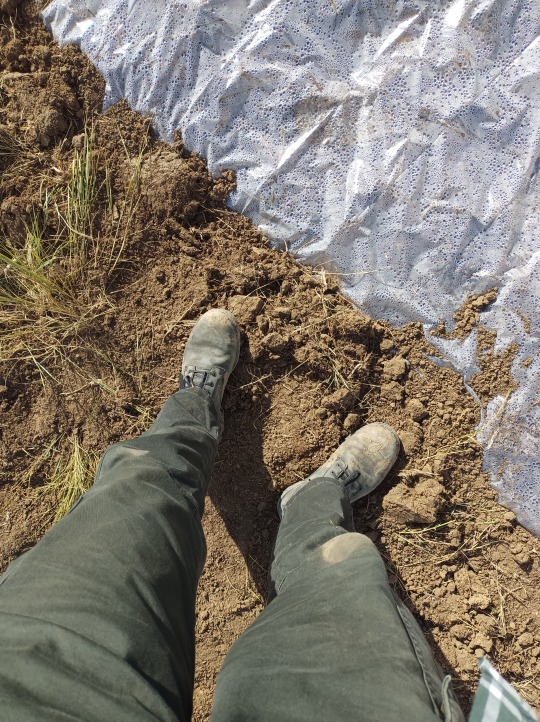
Field work is not glamorous.
It doesn’t matter what field you work in. Often times you’re outside for hours on end, the weather doesn’t cooperate when you need it too, you’re covered in sweat, in dirt, you’re overworked, you’re underpaid, your organization is understaffed, you don’t have the resources or the equipment you need to do the work, and trying to get people to give a shit and effect the change that needs to happen is a perpetual uphill battle that rivals Sisyphus’s eternal punishment. But you adapt, you improvise, and you do the work anyway.
Because it’s important. Because it matters. To me. To you. And to every living thing on this planet. You do it so things can grow and thrive.

Part of my job doing restoration work is removal and management of invasive species, like this Mullein pictured above. Now, Mullein is a plant that originated in Europe and Asia and was brought over to North America for cultivation purposes.
However, it didn't originate in the ecosystems in N. America, didn't evolve along with the local flora and fauna, it has no biological checks in the Great Plains to keep it from overrunning an area like it would in Europe or Asia. Not having any biological checks allows species to create monocultures, which isn't great because it reduces the overall biodiversity of an ecosystem, making it less robust and unable to support the vast array of wildlife you should find in a given area. Some species in the Great Plains do utilize the Mullein as a resource, but again, since it didn't evolve here many species are essentially losing food and habitat because of this plant.
Monocultures also reduce the effectiveness of a habitat's ecosystem services that help support life for all living organisms. Including us. Clean air, clean water, nutrient rich soil to support the growth of food, capturing carbon to sequester to reduce climate change... All reliant on biodiversity. All reliant on populations of native plants.
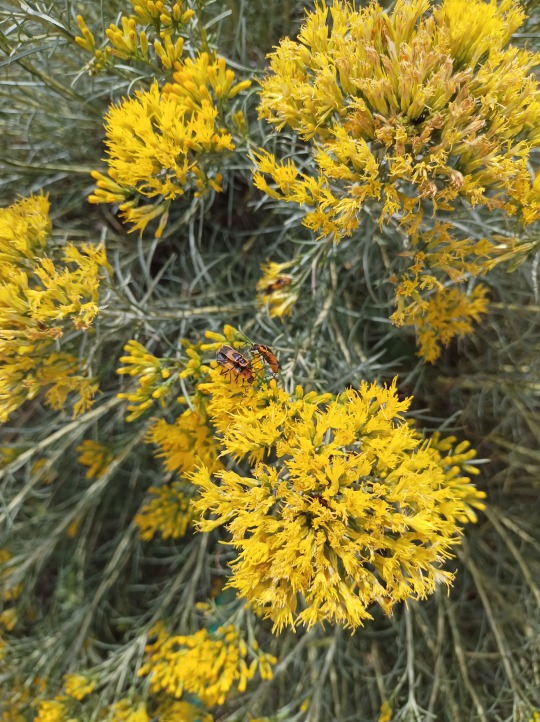

It's not enough to just remove invasive species though. You can't take something out, without putting something back in. Good land management and stewardship practices should also restore ecosystems. Rabbitbrush and Rocky Mountain Bee Plant are both species that are native to my local area, and are a resource for all manner of species.
And that Bee Plant, we planted that last season. It was the only one that grew, but look at all the seed pods on that thing! Hopefully those seeds will go on to make even more Bee Plants and support even more wildlife!
I watched this documentary series last week for work and I'd highly recommend it. It's about the native seed supply chain in the western United States for restoration efforts. A really large area, that needs as much helps as it can get.
https://ser-insr.org/native-seed-film - You can watch it in sections, or they have a couple of different lengths depending on the time you have. But if you only have 12 minutes to give, for sure watch the introduction.
Now, I'd like to point out, these large scale efforts are important, but restoration efforts don't have to be big or elaborate. If you have a spare planting pot or a backyard, you have the ability to restore native habitat. You can bring those ecosystems to you. And it doesn't necessarily require you tearing out your whole yard or sacrificing the plants you do grow.
It may require a bit more homework (you're gonna have to research what plants are native to where you live), and some trial and error, but there are a lot of gorgeous native plants out there that require very little work once they're established compared to "traditional" garden plants.
Humans have carved out huge swathes of land for our own purposes, often to the detriment of other living things and ourselves. We've destroyed entire habitats and ecosystems due to human vanity and simply walked away. Cut our losses. Those habitats and ecosystems are lost. But the land is not gone. And who's to say all those things that are lost can't be found.
It's not easy work, but with some compassion, and a little bit of knowledge, and the willingness to be patient, perhaps we can weave the land back together. Not the way it was, but rather better.
A ghost can dream, right? And perhaps this Pronghorn does too.

It's hard to appreciate the subtle beauty of the prairie. It's not a forest. Not the ocean. Most people might only see grass and not see the richness. The diversity. But I've done a shit-ton of digging this week to try and install a native plant garden.
Field work, manual labor and sweating outside with a shovel, is not glamorous.
But I'm doing this so people can hopefully see the beauty of the prairie, so they can see the beauty in the land around them and perhaps consider planting some native plants of their own. So every living thing out here, big or small, can have a home.

And here's a Megacyllene (sp?), probably a Locust Borer Beetle. It has wasp stripes to dissuade predators from trying to eat it.
#nature#field notes friday#restoration work#short grass prairie#plants#habitat restoration#native plants#locust borer beetle#pronghorn#rocky mountain bee plant#rabbit brush#mullein#land management#land stewardship#native seed restoration#little ghost on the prairie
27 notes
·
View notes
Text
It's been rainy for days now. Great for the plants, yadda yadda, but man, we've gotta get shit done. We have to move an outrageous amount of very heavy stones from the back yard to (hopefully) create a little rock garden / habitat in the front, and we need to not be covered in mud in order to do that, so. Shape up, nature.
It also means that Wallaby, who grows bolder by the day, has been coming inside more often. Last night Marc looked in the kitchen and found him CURLED UP in one of Fidget's cat beds.
Little man is definitely starting to see the appeal of just living here. Like, "Hey, these people are feeding me, giving me fresh water, scritches, and now there's a tiny door into their house where I can poop in a box AND have multiple comfy places to sleep!"
Going to make him a neuter appointment today, and we'll work on getting him acclimated to eating in a trap.
He's such a good, funny boy. Just coos and makes hilarious noises at you, and to himself, the entire time. Non-stop commentary. Someone loved him, once. I wonder what happened.
7 notes
·
View notes
Text
Draconity and the Astral Plane
Nonhumanity, for me, has always been an experience comparable to escapism. It’s not a coping mechanism or a chosen experience, but it feels like the “other” in otherkin refers to another world. My dragonself exists in the astral plane, typically tied to headspace. I'm one of three headmates, all nonhuman and all existing in a space that's literally… space. I'm a space dragon.
I've always felt that I was some form of not-human, going through sporadic childhood phases of animal roleplay. I would cycle through various types of animals - a lion from the Lion King, a gorilla from Tarzan, sometimes alligators (which was really fun to roleplay in a pool.) I’d stalk the tall grass of my yard like a tiger, climb the stairs on all fours like a dog, tear into pork chops with no hands. Animality was a staple of my childhood imagination. Eventually this turned into dragon roleplay.
Dragons are incredibly flexible as a species, so I could stalk the grasses and tear up meat and growl and swim and attribute it all to draconity. I found myself looking up pictures of dragons online, loving the designs that had fur or feathers. I loved dragons that weren't the typical scaly, fire-breathing ones because they felt more like me. I imagined myself as those dragons, feeling the fur and scales and feathers on my own body. I didn’t realize at the time that I was seeing my own dragon body parts on another dragon and relating to it.
I don't remember when I learned about otherkinity, but hearing about it unleashed a wave of relief and validation and clarity. I wasn't alone in those moments when I would imagine myself with ears that could pivot toward the source of a sound or a tail that would swish back and forth behind me while I walked. Other people out there experience this same thing and there’s a name for it, which helped me to better understand myself.
When I discovered a bit more recently that I'm a system, I started working toward developing headspace. I needed a fully-formed plane of existence where I could go when not fronting. In a meditation session one day, I found myself taking the form of a dragon when I finally accessed headspace for the first time. I could never imagine flying around in “meatspace” (due to my fear of heights), but it felt so natural in headspace because it's all just actual space. Instead of the typical individual homes or rooms for us headmates (which is a common way to form headspace), we have planets. Instead of grassy hills or dense forests, there are galaxies and stardust. While a lot of dragons are exploring lakes and mountains and jungles, my natural habitat is among the stars.
When I am in my most dissociative state, I am also most like my dragonself. I escape to the astral realm to be in the quiet of the void for a while. I fly through star systems and visit the planets of my headmates. I explore my own planet, a home representative of me. Nothing here can hurt me or do me any wrong because it’s the closest to home I’ve ever felt. Sometimes I fall asleep while away in headspace and when I wake up, I feel the tingling remnants of my astral wings on my back and when I stretch, the wings stretch with me.
I don’t have a very conventional dragon experience. I don’t breathe fire, collect gold, eat meat, protect myself against knights, or see myself as a species that lives any place that would exist on Earth. My fur is white like starlight but sometimes also ghostly, like a galactic apparition (and I’ve drawn my dragonself in both these forms.) I have paws and claws, with a flowing mane of hair and a long non-prehensile tail. I look like the plainest OC ever created. But my story is still important because it’s a small part of a very large community with all sorts of different experiences. My story matters because it’s a part of something much bigger than myself.
10 notes
·
View notes
Text
This Might Be Controversial But...
Over the past 25 years we've removed 90% of our lawn and here's what happened. Chaos. Beautiful chaos.
Why did we do it?
For us it was simple. Most gardeners try to maintain these clean and sterile environments that are the exact opposite of what wildlife wants. The more we can stop being tidy, the more wilderness we can bring into our gardens and landscapes, the better habitat we provide.
We are changing the planet so quickly that plants and animals can’t keep up. I'm sharing all this with you today with the hope to spread the word about the importance of rewilding!
The majority of lawns and yards these days are causing ecological damage turning once biodiverse spaces into "green graveyards."
Did you know grass is the most irrigated "crop" in America? Yup. Lawns, not food. The majority of non native grass lawns support little to no life and require an immense amount of water and what's it all for?
Lawns originated in 17th century England and France whereby landowners would cultivate lawns around their estates as a symbol of wealth and status. Later, a boom in the United States made it to where manicured lawns became a symbol of the American Dream.
Doused with toxic chemicals to keep up with appearances, these lawns and the products used in them are displacing and eroding life all the way down to the microscopic organisms in the soil.
Today, we pay to see botanical gardens yet there's that potential in our own backyards.
Well, I'm not a 17th century aristocrat trying to show off the status of my estate.
Personally, I don't care what anyone thinks of my status. I have too much real work to do to create pointless chores for myself.
But, I'm grateful to show you what we have, in fact, created.
The insect population has skyrocketed. Birds, spiders, garden snakes and other species have moved in signaling a growing, thriving ecosystem.
Improvement in the soil quality and organic matter as well as cooled areas from canopy and mindful planting continue to be a priority.
Today we're surrounded by the constant melody sounds of the thousands of beings that call my garden home.
It's been a long 25 years, an ever evolving learning curve, but this long observation period has revived an understanding of Earth's language and how we speak it, too.
Earth said: “Let me breathe, allow me flourish, watch me grow, see my flowers in unexpected places, measure the success in hums of buzzing life, tend to my wild nature - carefully….remember the language that exists beyond words….the intuitive flow between all that exists. Remember your place within it all. "
And so we did, and we are.
We no longer have a sterile manicured lawn, we have a flourishing perennial pollinator ecological garden and we are not gardeners but stewards.
In many ways, the letting go of grass and allowing nature to go wild - is reflected in our own lives. Wanting to see what is real, what wants to come through, allowing for authentic-true expression to SHINE. And from that, beautiful things grow.
What are us humans here to do? What’s our purpose? And what does all of this mean?
Oh, and by the way, this isn’t a share demonizing the cutting of grass all together, or putting shade (no pun intended) on short grass lawns. Rather, posing the question ‘what is a lawn for’ & ‘can we find ways to create spaces that elevate our lives and the life around, simultaneously’?
As always, thank you for reading. I truly appreciate your time.
Maritza
Our Journey to Balance
#reflections#our journey to balance#awareness#gardening#garden#pollinators#ecosystem#mindset#flowers#soil#bees#butterflies
3 notes
·
View notes
Text

Books That Pair Well Together: Habitat Restoration: What It Is, Why It's Important, and How to Get Started, and Avian Neighbors: Being a Good Steward to Backyard Birds
So I started writing these little chapbooks every three months almost a year and a half ago; they're a fun way to do a little longer-form writing on a topic that I can get more than one article out of, and I like giving my newsletter subscribers freebie ebooks. I thought I'd share some pairings that go well together, starting with this one.
Avian Neighbors is a quick guide to making your yard/porch/balcony/etc. more bird-friendly. Some of it goes into the ins and outs of maintaining bird feeders, but I also talk a bit about how you can create habitat (including more food!) for your local birds with native plants.
That's where Habitat Restoration may help. It goes into more detail about the reasoning behind habitat restoration, but it also gives some direction as to how to get started on your own small-scale project, like a corner of your yard or a piece of porch.
You can find all my chapbooks on my website at https://rebeccalexa.com/books/. (Reblogs totally okay!)
#habitat restoration#birds#wildlife#ecology#restoration ecology#bird feeders#animals#nature#books#nonfiction books#chapbooks#self publishing#environment#conservation
49 notes
·
View notes
Text
I get the aesthetic appeal of things like bug hotels, but you can create a lot more insect habitat just by leaving a pile of wood in a corner of your yard, or stacking some rocks on top of bare dirt, or leaving old dead plant stems in place instead of removing them. Nooks and crannies are your primary goal, and creating them is completely free! It also generally require you to do less yard maintenance, whereas most of the commercial Mason bee houses, etc, require annual cleaning to be sanitary.
4 notes
·
View notes
Text
Diverse Legacy Sims 4 Challenge
Introduction
Welcome to the "Diverse Lifestyles" Legacy Challenge! This challenge spans 12 generations, each with a unique focus on different lifestyles, family dynamics, and animal care. Get ready to explore a variety of ways to live, from urban to rural, and everything in between.
Rules
Start with a single Sim who has the "Animal Enthusiast" trait.
Each generation must complete their specific goals before moving on to the next generation.
Mods and cheats are not allowed, except for aesthetic purposes.
Pets must be well taken care of and should not be neglected.
Generations
Generation 1: The City Dweller
Your founder loves the hustle and bustle of city life. They aspire to build a successful career while keeping a pet in their apartment.
Traits: Ambitious, Outgoing, Animal Enthusiast
Aspiration: City Native
Goals:
Reach level 10 in the chosen career.
Live in an apartment in the city.
Adopt a pet and ensure it thrives in the city environment.
Generation 2: The Suburban Family
This Sim dreams of a perfect suburban life with a big family and a yard full of pets.
Traits: Family-Oriented, Cheerful, Dog Lover
Aspiration: Super Parent
Goals:
Reach level 10 in the Parenting skill.
Have at least three children.
Adopt a dog and ensure it becomes a beloved family member.
Generation 3: The Rural Farmer
This generation embraces the quiet life of the countryside, focusing on farming and livestock care.
Traits: Loves Outdoors, Green Thumb, Perfectionist
Aspiration: Country Caretaker
Goals:
Reach level 10 in the Gardening and Cooking skills.
Own and take care of cows, llamas, and chickens.
Grow a large and diverse garden.
Generation 4: The Wildlife Explorer
This Sim has a passion for exploring the wild and studying animals in their natural habitats.
Traits: Adventurous, Loves Outdoors, Cat Lover
Aspiration: Jungle Explorer
Goals:
Reach level 10 in the Archaeology and Fitness skills.
Travel to Selvadorada and complete the Jungle Explorer aspiration.
Adopt a cat and ensure it accompanies you on your adventures.
Generation 5: The Eco-Friendly Innovator
This generation is dedicated to living sustainably and inventing new eco-friendly solutions.
Traits: Green Fiend, Genius, Maker
Aspiration: Eco Innovator
Goals:
Reach level 10 in the Fabrication and Handiness skills.
Create and maintain a sustainable home.
Adopt a pet and ensure it lives in an eco-friendly environment.
Generation 6: The Equestrian Enthusiast
This Sim has a deep love for horses and dreams of becoming a top equestrian.
Traits: Loves Outdoors, Active, Ambitious
Aspiration: Horse Whisperer
Goals:
Reach level 10 in the Riding and Fitness skills.
Own and train at least two horses.
Win at least five equestrian competitions.
Generation 7: The Artist in the Countryside
This generation finds inspiration in nature and pursues a career in the arts while living in a rural setting.
Traits: Creative, Loves Outdoors, Cat Lover
Aspiration: Painter Extraordinaire
Goals:
Reach level 10 in the Painting and Photography skills.
Create a collection of nature-inspired artwork.
Adopt a cat and feature it in your artwork.
Generation 8: The Urban Socialite
This Sim thrives in the social scene of the city, balancing a busy social life with pet care.
Traits: Outgoing, Materialistic, Dog Lover
Aspiration: Party Animal
Goals:
Reach level 10 in the Charisma and Mixology skills.
Host at least 10 social events.
Adopt a dog and ensure it is well taken care of.
Generation 9: The Academic Scholar
This generation is focused on academic achievement and research, with a special interest in animals.
Traits: Genius, Bookworm, Animal Enthusiast
Aspiration: Academic
Goals:
Reach level 10 in the Research & Debate and Logic skills.
Complete a degree at university.
Adopt a pet and conduct research on its behavior.
Generation 10: The Celebrity Influencer
This Sim uses their fame to advocate for animal rights and promote different lifestyles.
Traits: Self-Absorbed, Outgoing, Good
Aspiration: World-Famous Celebrity
Goals:
Reach level 10 in the Media Production and Charisma skills.
Gain at least 1 million followers on social media.
Adopt a pet and feature it in your content.
Generation 11: The Wilderness Survivalist
This Sim prefers living off the grid and mastering survival skills in the wild.
Traits: Loves Outdoors, Loner, Self-Assured
Aspiration: Outdoor Enthusiast
Goals:
Reach level 10 in the Herbalism and Fishing skills.
Live off the grid and avoid modern conveniences.
Adopt a pet and ensure it thrives in the wilderness.
Generation 12: The Family Legacy Keeper
This generation focuses on preserving the family legacy and ensuring the well-being of future generations.
Traits: Family-Oriented, Ambitious, Good
Aspiration: Successful Lineage
Goals:
Reach level 10 in the Parenting and Charisma skills.
Have at least four children.
Adopt a pet and ensure it becomes part of the family legacy.
Conclusion
Complete all the goals for each generation to successfully finish the "Diverse Lifestyles" Legacy Challenge. Enjoy the journey and create lasting memories with your Sims and their beloved pets!
6 notes
·
View notes
Text
Cheaply Starting Seeds
This is my fourth post in a series I’ll be making on how to increase biodiversity on a budget! I’m not an expert--just an enthusiast--but I hope something you find here helps!
Having a high-quality seed-starting setup can feel like an ultimate but distant dream. An entire shelf--an entire room, even, filled with grow lights and plant trays in the optimal setup to make tons of plants? Tons of garden tools, each with a diverse and dedicated purpose? That’s just not an option for some of us. But that doesn’t mean we can’t get started at a low cost!
Seed Starting Set-Ups
Speaking from a somewhat biased Floridian perspective, I’ve had great success starting seeds outside! My usual set-up is on a rarely-used outdoor patio table that’s moved to a sunny spot in the yard, but I’ve even grown seeds in solo cups on sidewalks, or directly in the ground, with great results!

Some seeds grow best when they go through a cold period before germinating, while other seeds aren’t affected much by it and just wait for warm weather. As such, a viable option is to sow your seeds in late fall, let winter roll by, and wait until the seeds sprout on their own come spring! I would try and mark off where you planted said seeds, so you don’t lose track of them and accidentally dig them up.

Alternatively, if you want to get started while it's cold outside, a popular option I've seen is to grow in milk jugs! There's a lot of different ways to do it--everyone has their preference--but if you're already drinking things like milk or juice or sweet tea, and you're going to get jugs at some point in time--why not use them for gardening?
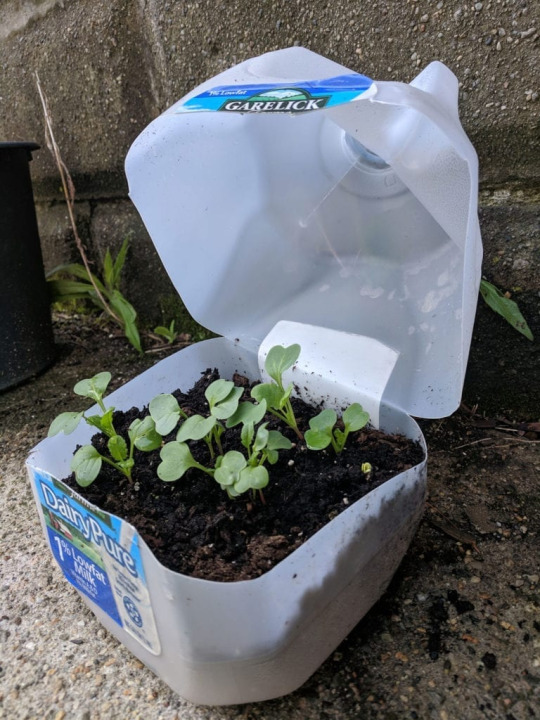
An easy way to clear up a section of lawn to create open gardening space is by using a sheet mulching or lasagna gardening method (though I like to call it the Cardboard Snuff-Out). Place cardboard or newspaper down in fall/winter to mark out where you want to garden. Layer compostable materials like grass clippings and wood chips on top of it, or potting soil/bagged compost. It’ll decompose over Winter into an organically rich bed that’ll have killed the grass and weeds underneath it. You don’t have to break out any tools and sweat over it come spring, and the cardboard itself will slowly decompose as well!

Though it's often recommended to plant things directly into the ground to decrease watering needs and increase nutritional independence, there’s plenty of reasons you may not be able to. Whether you’re renting, living in a place without a yard, or even just can’t or don’t want to break ground in a yard, you can still help biodiversity by growing in pots. Some plants have rather extensive root systems and aren’t well suited for pots, but there are still plenty of options available for plants that’ll boost biodiversity, be beautiful to look at, and grow just fine in pots! A recommendation is to get a larger pot, if you’re able, as it’ll hold onto more water and need watering less often. Not only are potted plants great for providing food for insects, but they can be shelter for other creatures too--there’s been a good few times I’ve moved a pot and found a frog or toad living underneath it.

If you don’t have room for pots on the ground, you could consider using hanging pots or window boxes! These can be great and easily-maintained options to provide food and habitat for insects and birds in an urban living situation like apartments or townhouses, but they can also be a fun way to add even more habitat to an already-robust home garden. You can even make an entire mini habitat in a window box or pot! I can personally say I’ve seen tons of pollinators visit my yearly hanging basket garden that consists of about five to seven plants, and I’ve always loved the idea of having a window box for blooms right out my window. Just make sure that it’s safe--make sure they’re securely fixed, and that whatever they’re hanging from can handle their weight when they’re freshly watered and loaded with plants.
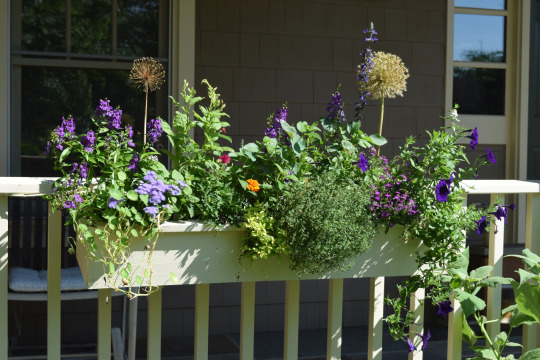
If you want to start indoors, you don’t necessarily need grow lights or heat mats (though it will make things a bit easier.) I’ve successfully grown milkweed, peppers, tomatoes, zucchinis, and even sprouted lemon seeds in college dorm rooms, and kept tomato and pepper plants in a dorm room on a sunny windowsill. For the most part, you need a nice and sunny window, some kind of container, and a source of heat (in my case, I used anything from a space heater to the warmth of my laptop running nearby. If you don’t have any sunny windows, or enough windowsill space to start plants on, its possible to obtain cheaper grow lights. One year, my mom bought me some gooseneck grow lights that could clip onto things for cheap off of Amazon. (Fair warning, though, they did light up my entire room in purple. I lived alone that year (covid year, my roomies bailed), so it was fine, but it was kind of trippy,)
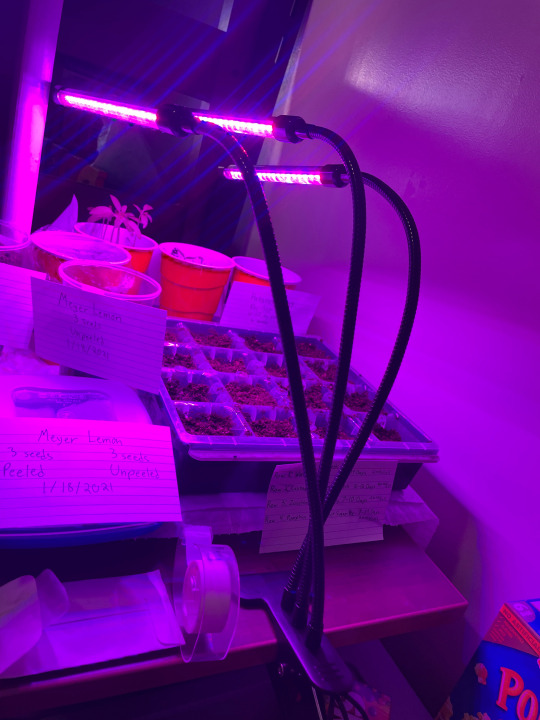
Another year, when I was in an apartment on my own, I bought a grow light modeled like a normal light bulb from the lightbulb aisle in Lowe’s and put it in my desk lamp. Growing seeds indoors can make them grow fast and leggy, so it’ll help if you can keep a desk fan on them so they focus on growing strong instead of tall and fast.
If you’re fortunate enough to have a friend with a nice set up, you could see if they’re willing to let you borrow some of their space to start your own plants as well! My set-up in college was by no means High Class, but I was still more than willing to start seeds for my friends who asked!
Containers for Seed Starting
So now that we’ve talked starting seeds indoors and out, we need to address what to start them in. It’s important that whatever you’re using has drainage holes, and be large enough to support your plant (starting something like milkweed or a squash in a tiny little pot won’t yield great results). Fortunately, there are options here!
If you’re looking to buy pots, Dollar Tree will sell some small plastic pots for cheap in the spring! They’re kind of thin, and won’t last forever, but they’re great for a few uses and don’t cost a lot of money. Something that’s a bit more pricey but are longer-lasting, in my experience, are the Burpee SuperSeed trays. They come in different sizes, but I’m fond of the 16-cell trays--they have silicone bottoms and are made of a nice solid plastic with a tray to hold water, so they hold up for a long time and are easy to clean and reuse!
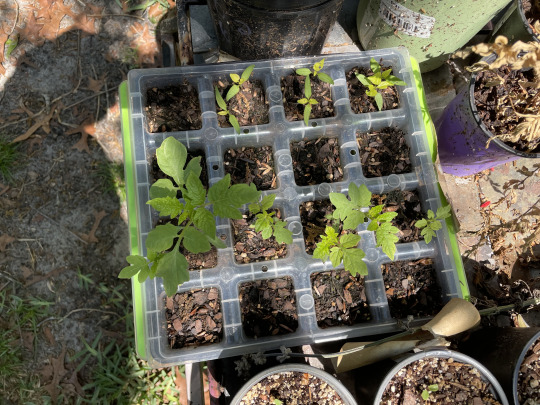
Burpee seed tray, my beloved.
What’s better than a cheap pot? Free ones, and there’s plenty of options there! I’ve seen people use toilet paper or paper towel rolls as pots by folding the bottoms in and have it work well for them! I think this method would work best if you had some kind of tray to keep them moist, because mine dried out fast last time I tried this method. I’ve also seen people make pots out of newspaper with a few different methods, and the people who use this method love it--apparently, the roots pass through the paper easier and it decomposes faster when buried, so you can just transplant the whole pot and avoid any kind of transplanting shock. If you don’t have any newspaper on hand, you can likely ask your friends or neighbors!

I’ve gotten lots of mileage from reusing old containers by poking a few holes in the bottom with knives or scissors--just be careful while you’re doing it! I, personally, am more likely to use an already-used solo cup for it--they’re a nice size, so they hold a good amount of soil and moisture and give the seedling a good amount of root space. I tend to write the plant information on the side of the cup in sharpie marker, or on an index card in pen. I’ve also heard of people making use of egg cartons, fruit containers, yogurt cups, milk cartons, soda bottles--the more you start thinking about what you could easily poke a hole in, the more options start coming around!
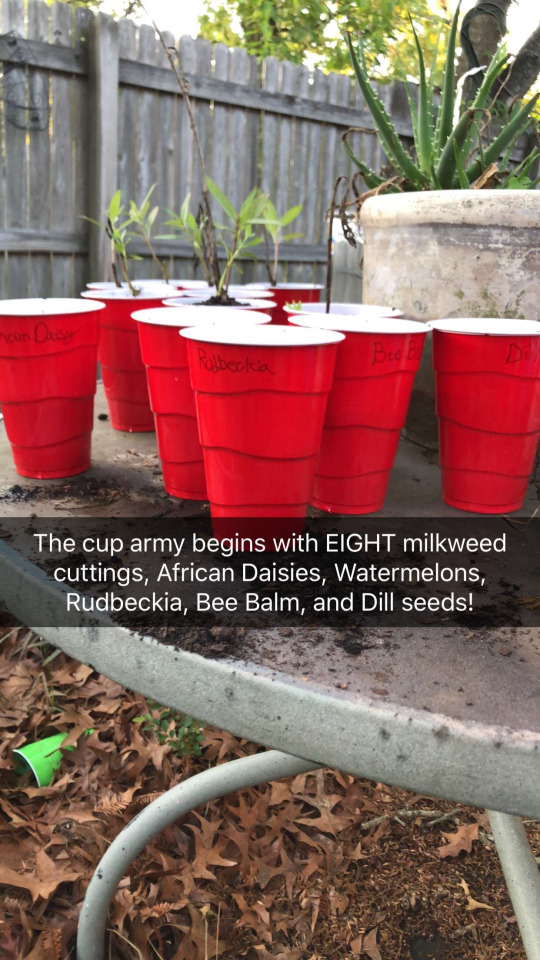
This photo may be from 2018, but I'll still regularly reuse cups like this! They're also great for cuttings!
As you start planning to move your seedlings into the ground and preparing planting sites, you’ll likely need a few tools to do it! How do you get these? You may be able to borrow some tools from a neighbor! As long as you make sure to return them in good condition, depending on how friendly your neighbors are, they might be totally fine with you borrowing their tools for awhile. If you don’t want to take that route, there may be a tool library you can borrow from, or a mutual aid group that can loan you tools for awhile. Either way, borrowing tools is cheaper than buying them--though, if you do have to buy tools, cheap hand-tools from Walmart or the dollar store work just fine. They’ll even last a good while if they’re taken care of when not in use! I've even seen places like Ross sell some tools and pots in spring!
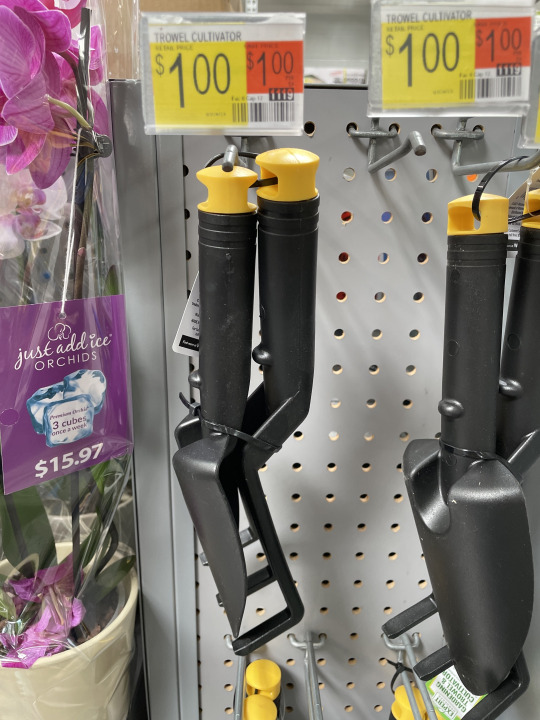
Spotted in a Walmart gardening section by the registers, 2023.
Of course, your mileage may vary with these. I genuinely cannot think of the last time my house got a newspaper, and as I've mentioned I don't have to worry about snow. Similarly, maybe you don't use plastic cups when you can help it, or don't have a particular affinity for eggs and yogurt. Maybe there isn't a tool library in your area--I sure don't know if there is in mine--but it could still be worth poking around and asking a neighbor!
That's the end of this post! My next post is gonna be about ways to support your plants for cheap--we're gonna be talking compost, mulch, and trellises. Until then, I hope this advice was helpful! Feel free to reply with any questions, your success stories, or anything you think I may have forgotten to add in!
#biodiversity#solarpunk#gardening#outdoor gardening#growing from seed#budget gardening#cheap gardening#indoor gardening#ani rambles#out of queue#the biodiversity saga#I can make a post later about how I prepare solo cups for being used as pots if yall want#I've found its safest to just use a nice pair of scissors and keep the cup upside-down on the table while I cut into the bottom#and when i say 'take care of the tools when not in use' i mean 'dont be me and leave a cheap shovel from dollar tree out in the rain'#it had a wooden handle and it basically just like. rotted. fell apart in my hand when I picked it up#generally keeping tools in the garage will also help them not rust as fast too#but if you're gonna leave them outside at least put them in shade#the number of times i have lost feeling in my hands because i picked up a hoe that was laying in the sun and fuckin SCALED my palms#its not fun. dont do it. maybe its a Floridian problem but still#if you read all these tags. uh. shovel emoji. idk. sorry dude.
219 notes
·
View notes
Text






The Gentle Presence of a Mourning Dove
This morning, I was greeted by the serene presence of a Mourning Dove perched gracefully in my neighborhood. These gentle birds, with their soft cooing and peaceful demeanor, bring a touch of tranquility to our bustling urban environment. 🌿✨
A Closer Look at Mourning Doves
Mourning Doves are known for their plaintive cooing sound, often mistaken for an owl's hoot. Recognized by their slender bodies, long tails, and soft, grayish-brown feathers, they are a common sight across North America. 🕊️💚
Observing Their Behavior
Watching the Mourning Dove this morning, I was struck by its calm and composed manner. These birds are often seen in pairs or small groups and are known for their strong pair bonds and dedicated parenting. 🥰
The Importance of Urban Wildlife
Encounters with wildlife like this Mourning Dove remind us of the importance of preserving natural habitats within our cities. Urban green spaces provide a refuge for wildlife and enhance our well-being, offering a vital connection to nature. 🌳🌼
How to Attract Mourning Doves to Your Yard
Want to invite these peaceful birds to your yard? Set up bird feeders with a mix of seeds like millet, cracked corn, and sunflower seeds. Providing a clean water source and creating sheltered areas with shrubs or trees will make your garden more inviting for Mourning Doves. 🌿🌺
Conclusion
Let's take a moment to appreciate and protect the wildlife that shares our urban spaces. Their presence enriches our environment and brings a sense of peace and tranquility to our daily routines. 🌞🕊️
📸 Thank you for enjoying this serene moment with me. Please like, reblog, and share your thoughts! 🙏💖
#photography#nature#naturephotography#wildlife#bird#birds#originalphotography#landscapephotography#travelphotography#photographersontumblr#urbanwildlife#hiddenbeauty#birdwatching#naturelovers#wildanimals#urbanparks#peacefulmoments#wildlifeconservation#birding#wildlifephotography#wild animals#colorado
6 notes
·
View notes
Text

A single dragonfly can eat hundreds of mosquitoes a day. I swear by this trick to attracting dragonflies and getting rid of all the mosquitoes
Morgan Reed
Contributing Writer
The battle against mosquitoes can feel never-ending, especially during warmer months when these pesky insects are at their peak. Apart from being annoying, mosquitoes pose health risks as carriers of diseases such as malaria, dengue, and Zika virus. With this in mind, it’s no wonder that finding an effective way to eliminate mosquitoes is a priority for many people. Fortunately, nature provides a simple yet efficient solution: dragonflies! These incredible insects can consume hundreds of mosquitoes each day, offering a sustainable method of mosquito control.
If you're tired of using chemical-laden repellent sprays and seeking a more natural way to get rid of mosquitoes, then this article is for you. By attracting dragonflies to your garden or outdoor space, you can significantly reduce the mosquito population around your home. Read on to discover the steps and tips that will turn your yard into a dragonfly haven and create a mosquito-free environment.
Why Dragonflies Are the Best Mosquito Predators
Dragonflies are not just beautiful to look at; they are also voracious mosquito predators. An adult dragonfly can eat up to hundreds of mosquitoes in a single day. Their predatorial skills are unmatched, making them a key player in controlling mosquito populations naturally.
Creating a Dragonfly-Friendly Environment
Attracting dragonflies to your backyard is easier than you might think. Here’s how you can make your garden inviting for these beneficial insects:
1. Build a Pond
Dragonflies lay their eggs in water, so having a pond or water feature in your garden is crucial. It doesn't have to be a large pond; a small one will do. Ensure it has shallow edges and some aquatic plants to mimic a natural habitat.
2. Add Native Plants
Planting native grasses and blooming plants around your pond will provide perching spots for dragonflies to rest and hunt. Native plants are more likely to attract insects that dragonfly larvae feed on, ensuring they have a food source.
3. Avoid Using Pesticides
Pesticides can be harmful to dragonflies. Avoid using chemical pesticides in your garden to create a safe environment for these insects. Instead, focus on natural pest control methods.
4. Install Flat Rocks
Dragonflies love to bask in the sun, and flat rocks provide the perfect surface for them to do so. Place some flat rocks around your pond area to attract sunbathing dragonflies.
5. Keep Water Clean
Dragonflies need clean water for their larvae to thrive. Ensure your pond's water is clear of pollutants and populated with beneficial creatures like aquatic snails that help keep the water clean.
By following these steps, you’ll be well on your way to attracting dragonflies and reducing your mosquito problem naturally. Not only will you enjoy a more pleasant outdoor experience, but you'll also enhance your garden's ecosystem.
3 notes
·
View notes
Text
tumblr ate the original post I typed up on my phone this afternoon after my walk and I spent the rest of the day procrastinating making another, but here we go.
I drove to a nearby nature trail for today's walk. I usually don't go on paved trails because I like looking for tracks and stuff, but this was nice.


These are pretty, but unfortunately it sucks. This is Japanese barberry, an extremely troublesome invasive in North America. It pushes out native plants because it forms dense thickets, and it raises the pH of the soil and depletes nitrogen, so other plants struggle to grow. It's also an unusually perfect tick habitat, creating population booms that may even contribute to the rise in Lyme disease cases. Deer won't even eat this shit. It's EVERYWHERE. A couple of states have banned it, but many others continue to allow people to plant it as an ornamental.


This is American bittersweet. It's native, and it has great wildlife value, but you might not want this in your yard either, because it can be a very enthusiastic vine and choke out young saplings. Womp womp.
Bonus penalty picture:

The remnants of a hawk's snack, on the edge of the creek. I'd say it was a Downy woodpecker, which is an adorable little bird, but hawks gotta eat, too. Is it weird that I'm good at finding and IDing predators' kill sites, or is that something you guys like about me?



9 notes
·
View notes